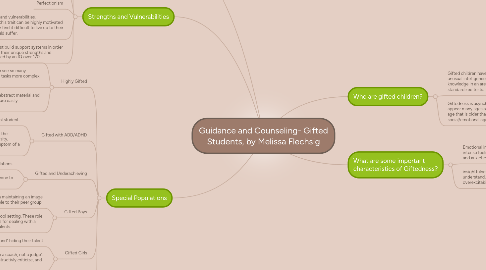
1. Special Populations
1.1. Highly Gifted
1.1.1. Sometimes defined by an IQ over 170
1.1.2. Simple is complex- gifted children see so many possibilities this may make simple tasks more complex for them.
1.1.3. Complex is simple- abstract material and underlying patterns are easily understood.
1.2. Gifted with ADD/ADHD
1.2.1. One example of the twice exceptional student.
1.2.2. Must be carefully diagnosed because some of the characteristics of ADD and Giftendness (intensity, overexcitability) overlap and may not be a symptom of a disorder.
1.3. Gifted and Underachieving
1.3.1. They may fall into a variety of special populations.
1.3.2. Must be given support and someone to listen to them.
1.4. Gifted Boys
1.4.1. Concerned with maintaining an image that is acceptable to their peer group
1.4.2. Espose them to role models in the school setting. These role models should be able share strategies for dealing with a "macho culture" without hiding their talents.
1.5. Gifted Girls
1.5.1. May go "underground" hiding their talent
1.5.2. Parents and teachers must learn to "be a coach, not a judge". This means they must encourage, constructivly criticize, and praise.
1.6. Gifted and Low Socioeconomic
1.6.1. Gifted students from poverty recognize that their backgrounds are not equal to peers from middle class households. They may not have access to resources considered common place in more affluent homes.
1.6.2. Looping can be and effective strategy for serving this population because this helps the teacher build a strong relationship with the students and families.
1.6.3. Low teacher-student ratio can benefit this population. Smaller class sizes encourage sharing and builds close ties.
2. Strengths and Vulnerabilities
2.1. Introversion
2.2. Worry
2.3. Perfectionism
2.4. Each characteristic carries certain strengths and vulnerabilities. Perfectionism is one example. Children with this trait can be highly motivated to succeed academically. However, they may find it difficult to live up to their unrealistic expectations and self-esteem could suffer.
2.5. Parents and teachers must build support systems in order to help them understand their unique strengths and characteristics.
3. Developing Leaders and College Admission
3.1. Teachers and parents should work to make gifted students aware of opportunities to develop their leadership skills.
3.2. Help students set short and long term goals for education
4. Who are gifted children?
4.1. Gifted children have many different characteristics. They often show unusual intelligence as measured by superior ability to reason, expert knowledge in an area of interest, or above grade level performance on standardized tests.
4.2. Giftedness is asynchronous development-- the child can appear many ages at once. The child may display an intellectual age that is older than his or her chronological and or social/emotional age.
5. What are some important characteristics of Giftedness?
5.1. Emotional intensity- can manifest in many ways including: intense feeling, inhibition, strong affective memory, fears and anxieties, critical self-evaluation, and others.
5.2. insightfulness, perfectionism, empathy/sensitivity, need to understand, excellent sense of humor, intensity, overexcitability
5.2.1. Some characteristics carry ce
